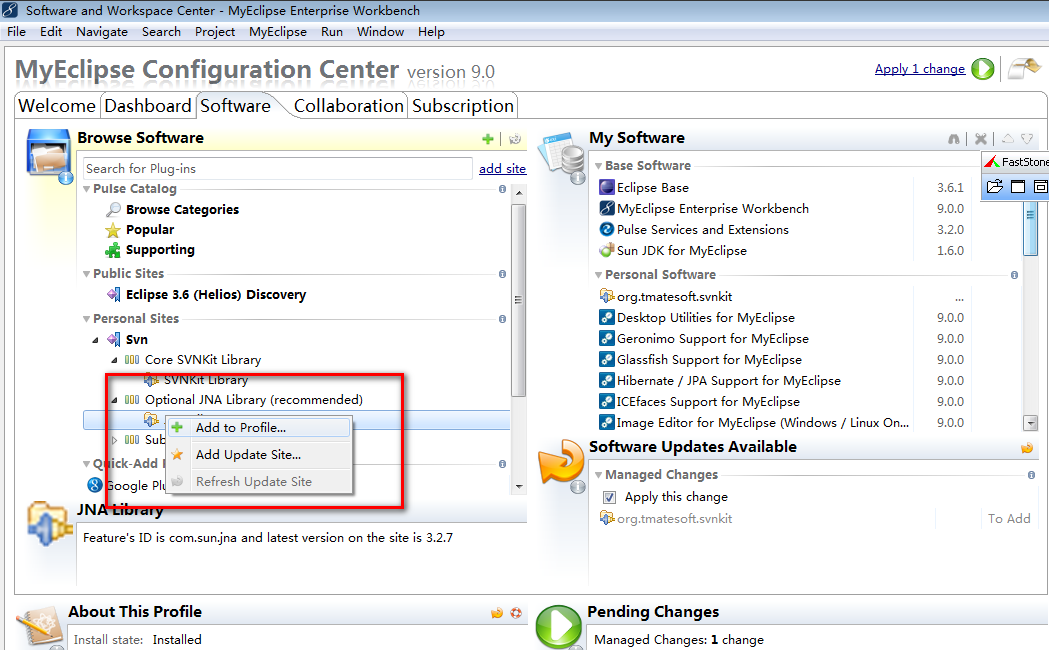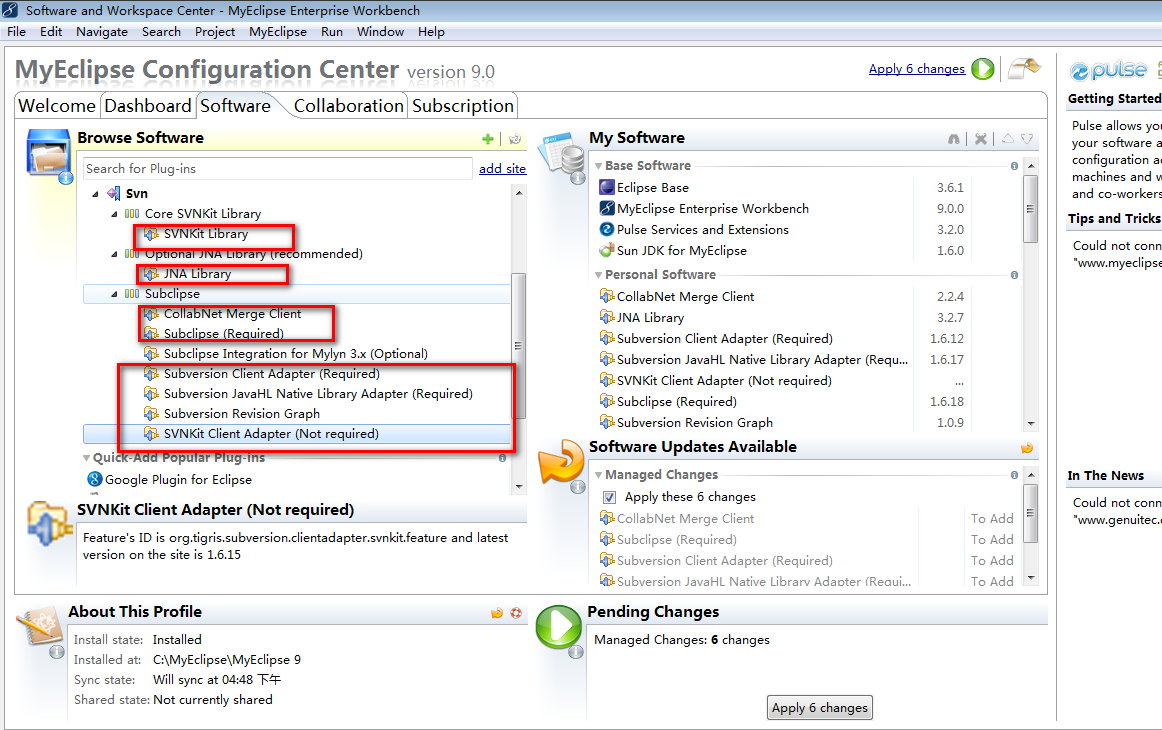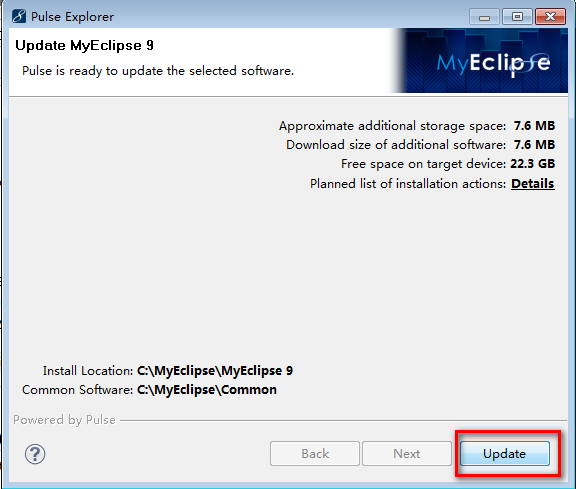MyEclipse 9.0 SVN 的安装
方法一:在线安装
1.打开HELP->MyEclipse Configuration
Center。切换到SoftWare标签页。
2.点击Add Site 打开对话框,在对话框Name输入Svn,URL中输入:http://subclipse.tigris.org/update_1.6.x

3.在左边栏中找到Personal Site中找到SVN展开。将Core SVNKit Library和Optional JNA Library添加(右键Add to Profile),Subclipse下面的Subclipse Integration for Mylyn 3.0可以不添加(特别注意,此处不要添加)。


4.在右下角窗格(Pending Changes )中点击Apply。安装重启后MyEclipse即可。



方法二:link安装
(1)svn的插件版本site-1.0.6.zip
(2)下载网址是:http://subclipse.tigris.org/servlets/ProjectDocumentList?folderID=2240
(3)从中解压出features与plugins文件夹,复制到D:\MyEclipse\myPlugin\svn里面,其它的*.xml文件不要
(4)在D:\MyEclipse\MyEclipse9.0\dropins下新建文件svn.link,在svn.link文件中添加如下的内容path=D:\\MyEclipse\\myPlugin\\svn 保存
(5)删除D:\MyEclipse\MyEclipse9.0\configuration\org.eclipse.update文件夹
(6)重启myeclipse就一切正常了。
检查是否插件安装成功,我们可以打开MyEclipse,在此路径下Window >> Open perspective >> other,看是否存在“svn资源库”这个选项
方法三:直接解压
下载SVN插件:site-1.6.10.zip
解压后将其全部文件拷贝至:D:\Program Files\Genuitec\MyEclipse 8.5\dropins(MyEclipse的安装目录)
重启MyEclipse即可出现SVN!
方法四:肯定可行的方法
(1)svn的插件版本site-1.0.6.zip
(2)下载最新的SVN包:
http://subclipse.tigris.org/servlets/ProjectDocumentList?folderID=2240
(3)从中解压出features与plugins文件夹,复制到E:\MyEclipse\myPlugin\svn里面,其它的*.xml文件不要
(4)复制下列java代码,修改路径并执行。
package app;
import java.io.File;
import java.util.ArrayList;
import java.util.List;
/**
* MyEclipse9 插件配置代码生成器
*
*/
public class PluginConfigCreator
{
public PluginConfigCreator()
{
}
public void print(String path)
{
List<String> list = getFileList(path);
if (list == null)
{
return;
}
int length = list.size();
for (int i = 0; i
< length; i++)
{
String result = "";
String thePath = getFormatPath(getString(list.get(i)));
File file = new File(thePath);
if
(file.isDirectory())
{
String
fileName = file.getName();
if (fileName.indexOf("_")
< 0)
{
print(thePath);
continue;
}
String[] filenames = fileName.split("_");
String filename1 = filenames[0];
String filename2 = filenames[1];
result = filename1 + "," + filename2 + ",file:/" + path
+ "/"
+ fileName + "\\,4,false";
System.out.println(result);
} else
if (file.isFile())
{
String
fileName = file.getName();
if (fileName.indexOf("_")
< 0)
{
continue;
}
int last =
fileName.lastIndexOf("_");// 最后一个下划线的位置
String
filename1 = fileName.substring(0, last);
String
filename2 = fileName.substring(last + 1, fileName
.length() - 4);
result
= filename1 + "," + filename2 + ",file:/" + path + "/"
+ fileName + ",4,false";
System.out.println(result);
}
}
}
public List<String>
getFileList(String path)
{
path =
getFormatPath(path);
path = path + "/";
File
filePath = new File(path);
if (!filePath.isDirectory())
{
return null;
}
String[] filelist = filePath.list();
List<String> filelistFilter = new ArrayList<String>();
for (int i = 0; i < filelist.length; i++)
{
String tempfilename = getFormatPath(path + filelist[i]);
filelistFilter.add(tempfilename);
}
return filelistFilter;
}
public
String getString(Object object)
{
if (object ==
null)
{
return "";
}
return String.valueOf(object);
}
public String getFormatPath(String path)
{
path =
path.replaceAll("\\\\", "/");
path = path.replaceAll("//",
"/");
return path;
}
public static
void main(String[] args)
{
/*你的插件的安装目录*/
String plugin = "改成安装目录\\Genuitec\\svn";
new PluginConfigCreator().print(plugin);
}
}
这里需要注意的是修改成为刚才svn所在路径,建议改为绝对路径。比如我的svn在“/opt/soft/Genuitec/myplugins/svn/”,那么就这样:String
plugin =
"/opt/soft/Genuitec/myplugins/svn/";
用windows的朋友只需要设置你们的绝对路径就可以了,比如d:/myplugins/svn/。。。
5、找到“$myeclipse_home/configuration/org.eclipse.equinox.simpleconfigurator/”,打开其中的“bundles.inf”文件,为了防止分不清是不是我们自己后加的东西,在最后面多回几次车,然后粘贴第4步运行该java文件后,将输出结果全部拷贝到bundles.inf文件中,保存
6、重启myeclipse
7、import工程,看看最下面是不是多了一个“other”文件夹?没错,就是他了,我们的svn终于回来了!




 浙公网安备 33010602011771号
浙公网安备 33010602011771号